Josh Dovey and Claire Weston – Rathmines Farm
Found this little chap in the Hydrangeas last week!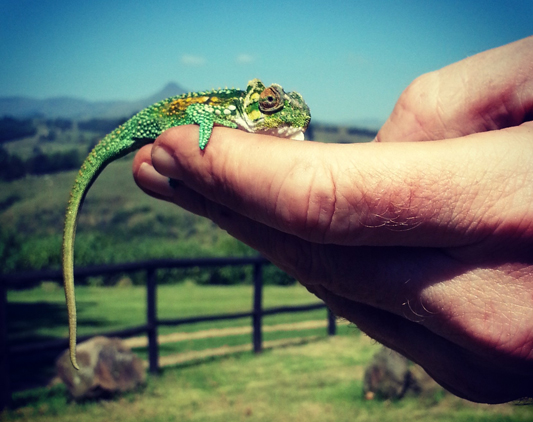
David and Helen Mann – Knowhere Farm
Have been hearing some loud barking coming from the forest across the uMngeni river from their farm. Baboons perhaps? Somebody mentioned it might be Samango monkeys calling (Ed: perhaps we need to setup a trail cam there sometime?)
Nigel Anderson – Lane’s End
Nice flock of Crowned Cranes that are very common adjacent to Lanes End farm at the moment, feeding on the spilled maize.
Rose and Barry Downard – Oak Tree Cottage
Two sightings this month of female Flufftails, possibly the Redchested Flufftails as I have heard their calls a few times recently in our garden. On both occasions she came fairly close to me, quite unconcerned by my presence as she seemed to be more focussed on foraging for food. Unfortunately I didn’t have a camera on hand either time to take any photos. No other unusual wildlife sightings this month, but lots of gorgeous sunrises and sunsets! The sunrise on Easter morning – the entire sky was a beautiful pink and golden colour, quite spectacular!
David and Alvera Crookes – Copperleigh Farm
Spectacular sunset over Mavela dam

Pink Everlasting (Helichrysum adenocarpus)

Senecio madagascariensis (Canary Weed)
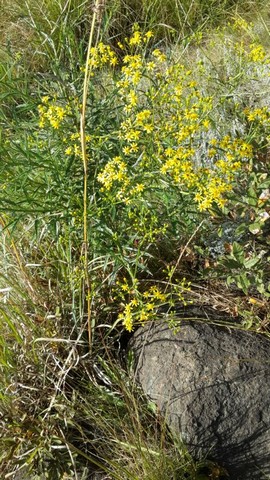
Dieter Setz – Wakecroft
Saw 7 Eland at the bottom of Wakecroft towards the umngeni a few days ago And lots of autumn colours.
 I found this little Datura man ready to pop, the other morning
I found this little Datura man ready to pop, the other morning
 Noticed these 2 beetles hiding from the cold and feeding on one of the last evening primroses.
Noticed these 2 beetles hiding from the cold and feeding on one of the last evening primroses.
Evert and Malvina van Breemen – Old Furth
In April we saw a young Honey Buzzard who took up residence in the trees near our bottom dam for a while and who was very clumsy about landings, causing great consternation to the Dabchick family on the dam. The Teal seemed largely unconcerned about it. The bottom dam also saw a long residency of a Spoonbill who kept the Herons and Egyptian Geese company for a few weeks. We also had a superb sighting of a juvenile Martial Eagle in the trees alongside this dam one morning. The ever-clumsy Gymnogene is still raiding the trees around the house and down the driveway. Spider wrapped up this moth very neatly.

A jackal was run over on the P130 outside Sagewood’s gate at the end of April. The jackal have been extremely vociferous at night and have been coming down quite low from the hills surrounding us, as have the baboon and vervet monkey troops. The plague of locusts is diminishing at last and we now have large flocks of little seed birds swarming all over the grasses on the hillside next to the house. The waxbills and firefinches come into the garden areas as well, which is a delight. The Sunbirds are also still very active in the garden.
We also had a surprise visitor in the kitchen early one evening in the form of a dark upper bodied snake with a salmon pink underbelly, who was fairly relaxed about being posted into a very large tupperware and taken outside. It behaved rather like some form of constrictor – any guesses as to the uninvited guest’s identity? We did not try to introduce ourselves
Thanks for the response from Pat McKrill about the snake sighting: “No guarantees, but it fits the description of a brown water snake, Lycodonomorphus rufulus – iVuzamanzi (Zulu) – pretty common up in that area, feeding mostly on fish, tadpoles and frogs. Just an observation, but at first glance, a relaxed Mozambique spitter making its way across the lawn can look pretty similar. Caution always urged.”
Brandon Powell – Bukamanzi Cottage
Last week I saw a genet or a serval (I don’t know which, but it was long legged and spotty with pointy ears) on the D17! Update after viewing pics of both on Wikipedia: I think a Genet, the Serval looks too big.
You can also mark me down for a couple of Duiker (D17, daytime and night-time) and Petrustroom Rd (night-time, opposite David Fowler’s) and Francolin (my house, D17) although the latter have stopped their calls now but they were going mad a few weeks ago. And a hare and a jackal (D17) Eds note: Perhaps you saw an African Wild Cat? that’s pretty special.
Ashleigh Crookes – Copperleigh Farm
Black Ants and eggs found under a rock on the farm
lots of locusts still about
mom found this tiny toad in the garden.
we rescued this mole from the dogs
Nikki Brighton – Old Kilgobbin Farm
My favourite things this Autumn month of April have been:
The sound of thick billed weavers snacking on Celtis africana seeds
A purple heron rising elegantly from the reeds
Forest edges festooned with yellow Senecio tamoides Very early in the morning, tree dassies calling – (why so late in the season?) the occasional wood owl and jackals, of course
Very early in the morning, tree dassies calling – (why so late in the season?) the occasional wood owl and jackals, of course
Athrixia phylicoides, Bushman’s tea – The muted mauve flowers and dark leaves felted grey underneath, blend beautifully with the rest of the faded colours in the landscape The shiny new leaves on Prunus africanus and the old ones swirling off in the breeze
The shiny new leaves on Prunus africanus and the old ones swirling off in the breeze
Lots of Reedbuck in the occasional still-green fields
Birds feasting on Vepris lanceolata fruit
Many interesting spoor in the mud as the dam level recedes
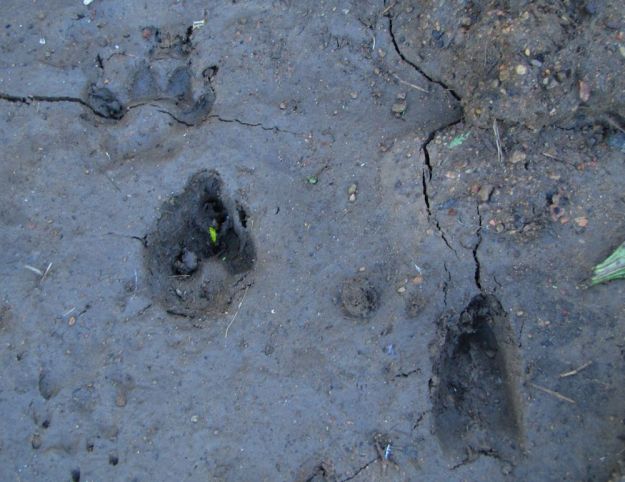
A lone Cape Parrot flying between forest patches – hope he finds his friends
A Bush Black Cap on a branch outside my window
Tiny bright purple Monopsis decipens flowering on forest fringes
 All the little birds which frequent the water bowl on my veranda – furtively looking about to make sure it is safe. So many butterflies – mostly white, but some emerald swallowtails too.
All the little birds which frequent the water bowl on my veranda – furtively looking about to make sure it is safe. So many butterflies – mostly white, but some emerald swallowtails too.
Masses of Phymaspermum acerosum – Curry’s Post Weed – in full bloom

Bridgette Bolton – Robhaven Farm
Please can someone put to rest my curiosity, and end a debate… What on earth is this caterpillar? (in fact, is it a caterpillar???)
Does it cocoon? Does it turn into a moth or butterfly? Are those its eggs on its back?
Why do they suddenly drop dead at the bottom of the tree in a stinky pile?
 Ed’s note: Pretty sure those are the eggs of a wasp that lays them in caterpillars to hatch. Were the caterpillars on a Celtis africana tree? Why not post them on this wonderful facebook page and see if an insect enthusiast can help you?https://www.facebook.com/groups/Butterfliesandbugs/
Ed’s note: Pretty sure those are the eggs of a wasp that lays them in caterpillars to hatch. Were the caterpillars on a Celtis africana tree? Why not post them on this wonderful facebook page and see if an insect enthusiast can help you?https://www.facebook.com/groups/Butterfliesandbugs/
Jason Londt, an expert in creepy crawlies tells us “The caterpillars are those of an emperor moth, and the eggs on the back of one are actually cocoons of a parasitic wasp”
Pat and Sandra Merrick – Albury Farm
Pat saw 3 jackal running around the farm mid-morning. A striped pole cat on the D 18
Buffstreaked chats spent many hours bathing in our rock pool over the past hot couple of weeks.

Common bulbul mom been feeding her 3 fully grown babies with worms. They sit just outside our kitchen on a tree branch, although I think mom is getting a bit fed up now and flies off to eat her own worms. Common Stone Chat.
Cape Robin flew into our window
I was looking for our 3 blue crane one morning and found them in a newly planted rye grass land next to the natural bush. As I watched a jackal ran out the bush and ran towards them. Thankfully they saw him and flew off. The jackal slunk back into the bush. Our crane are still around and arrive at the dam in the evenings, hopping up and down or running up and down the edge of the dam.
A pair of crowned crane have also been here nearly every day.
They do not like the Ngunis to come and drink near them and open their wings and run forwards trying to chase them away.
One evening I took the dogs for a walk. They were prancing around the dam, jumping and running for joy. As we walked on they flew ahead of us and landed in front of us on the hill. They seemed curious and kept following. Eventually when we were about 20 metres from them they flew off.
Saw jackal buzzard on stone wall. Reed cormorant on dead tree. He sat for a few minutes and then flew into the pond. He was on the ground for a while but could not see what he was eating as grass too long. It would have been a crab or frog.
4 natal francolin live in our garden somewhere where the grass is long. They are very shy and run off when approached. A black stork arrived at the dam and stayed for 2 days.

4 white breasted crows around house area. One morning, Pat saw a pair of Stanleys Bustards on lower part of farm.
 A hamerkop arrived in the garden after a storm
A hamerkop arrived in the garden after a storm
Wayne and Kathy Lourens – Aloe Ridge Farm
We have seen the usual Reedbuck, a duiker, Giant Mongooses etc. on Hopedale in general. Early in the month, our manager, David, found an injured raptor at his off-grid house on the top-farm. Kathy took it in to FreeMe for treatment, but here are some photos David took of it…
 As far as we can make out, it’s a Juvenile Rufous-chested Sparrowhawk (Accipiter rufiventris)
As far as we can make out, it’s a Juvenile Rufous-chested Sparrowhawk (Accipiter rufiventris)
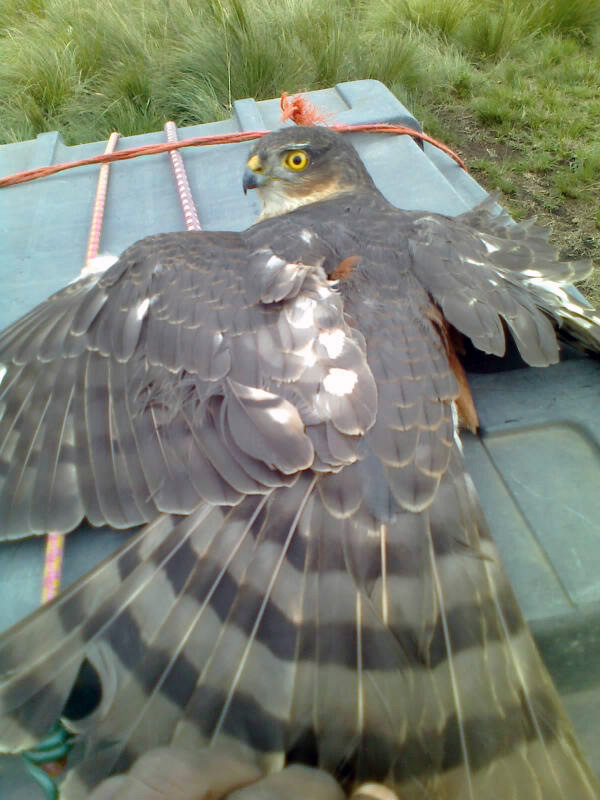 Over Easter weekend, we camped out with our caravan (called “Kat-a-Van”) on a new site above our top-farm dam, and on Sunday morning, hosted a short visit from our neighbours, Mike & Ann Weeden & their family, to be greeted by a Fish Eagle flying over the dam, & settling into one of the trees at the old ruin site. A week prior to that, while restocking our dam, a juvenile Fish Eagle gave us a regal fly-by. Its great to see offspring from breeding pairs in the valley.
Over Easter weekend, we camped out with our caravan (called “Kat-a-Van”) on a new site above our top-farm dam, and on Sunday morning, hosted a short visit from our neighbours, Mike & Ann Weeden & their family, to be greeted by a Fish Eagle flying over the dam, & settling into one of the trees at the old ruin site. A week prior to that, while restocking our dam, a juvenile Fish Eagle gave us a regal fly-by. Its great to see offspring from breeding pairs in the valley.
While clearing the tall grass on our new off-grid campsite, I spotted an amphibian hiding in the grass, a Striped Stream Frog (Strongylopus fasciatus), as there is a stream not far from where it was seen.
On Easter Sunday, as we were breaking camp on the top-farm, our manager, David, contacted us urgently on the cellphone, to say a large black & yellow snake was in the paddock where our breeding mares & their offspring were grazing. As the pack-up was nearly done, Kathy & I asked David to keep an eye on it, as we were leaving within 10 minutes, & would sort it out when we got down to the main Aloe Ridge farm. Kathy had her quadbike, so left ahead of me, & when I’d negotiated the 4X4 route down to Aloe Ridge as quickly as was safe while towing the off-road caravan – envisioning meanwhile that I’d be dealing with a possible M’fesi (Mozambican Spitting Cobra – Naja mossambica) or Rinkhals (Hemachatus haemachatus) – then collected my snake-stick from my study at a gallop, I arrived at where Kathy was standing under one of the old Pecan Nut trees, where she pointed out the well-camouflaged culprit, which, I was relieved to see, was a rather beautiful uMbalulu (Puff Adder – Bitis arietans), about 1 metre long. With Kathy’s help I carefully snared it in my snake-stick, & put it in an empty feed sack, then took it for a ride on the quadbike to the far end of the flood plain, where I released it on the fence line.
Going out from the farm to fetch staff in Howick after one of the holiday weekends, Kathy spotted a juvenile Serval on the D.244, about a third of the way up “Hopedale Hill”. She took a photo with her mobile phone camera, but it was not at all clear. After having both our tractors in pieces, our haymaking got off to a late start when Kathy’s tractor was rebuilt.
While out baling hay, a one-legged Stork followed Kathy quite closely, hopping towards her more than once. Perhaps its injury is keeping it local when the remainder have migrated?

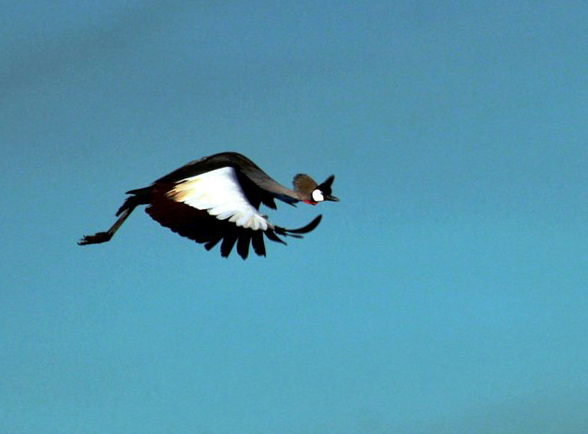
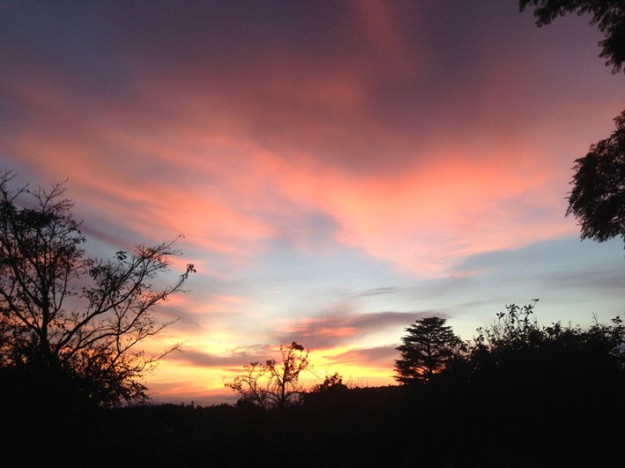



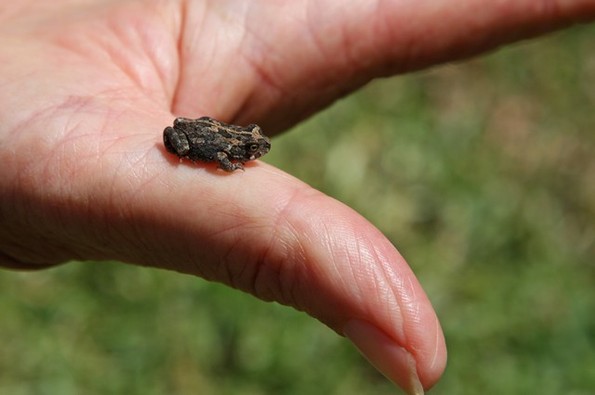

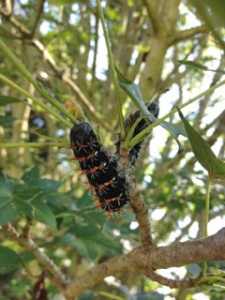

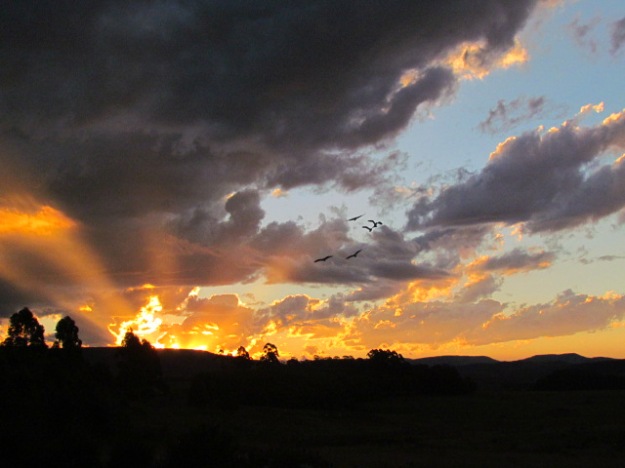



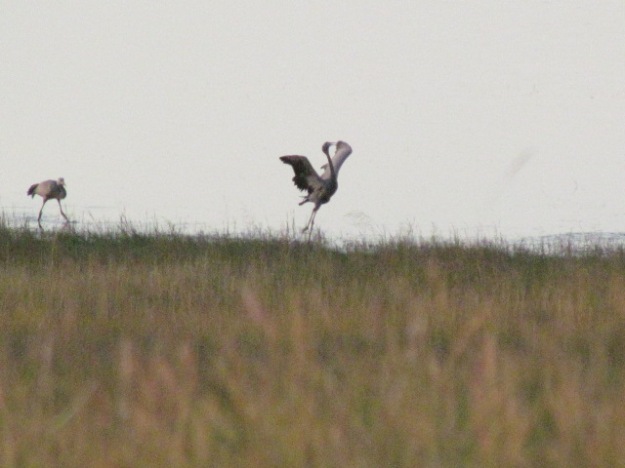








Wonderful stories and photos. Thanks
LikeLike
Incredible Wildlife Feast. Wonderful co-operative Sightings
LikeLike